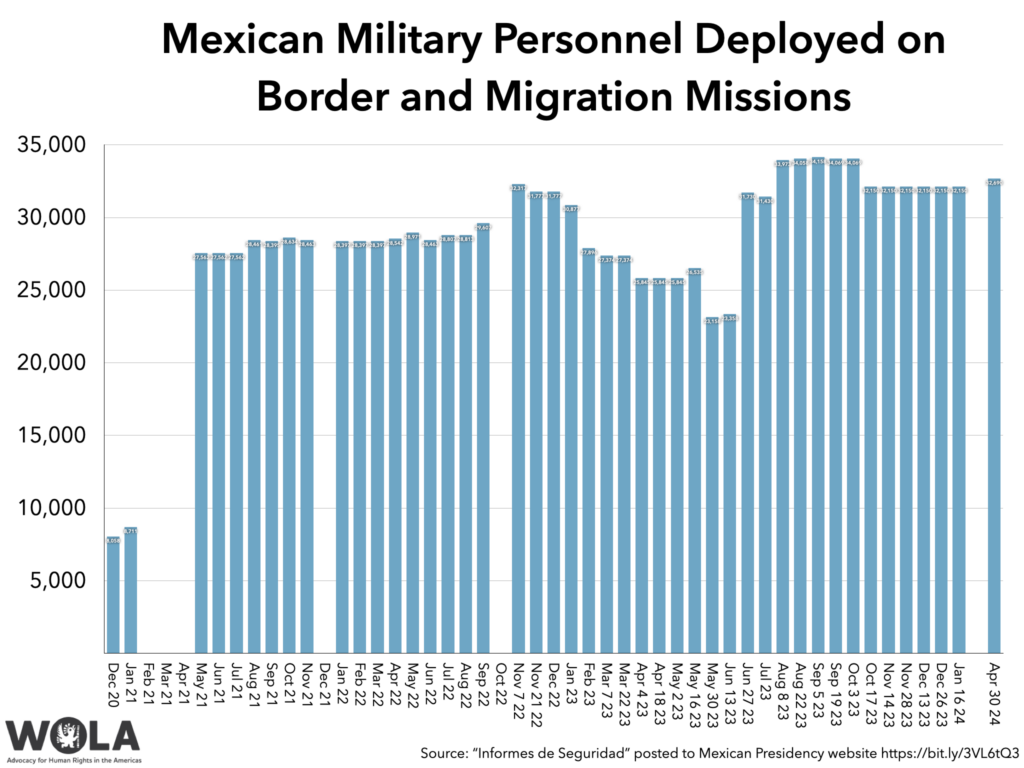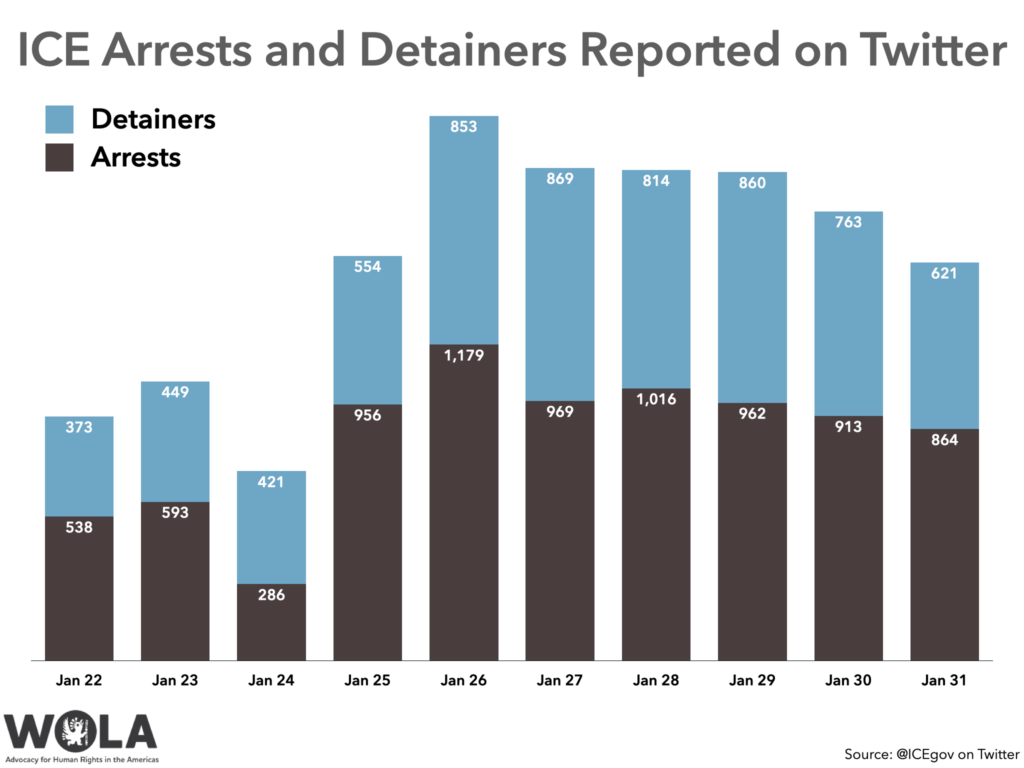With this series of weekly updates, WOLA seeks to cover the most important developments at the U.S.-Mexico border. See past weekly updates here.
Your donation to WOLA is crucial to keeping these paywall-free and ad-free Updates going. Please contribute now and support our work.
THIS WEEK IN BRIEF:
The many actions and changes following Donald Trump’s January 20 inauguration force a change in this week’s Border Update format. Instead of narratives organized under three or four topics, this Update organizes brief points under the following headings:
- A tariff threat and a Mexican military deployment: after President Trump threatened to levy tariffs on Mexican imports, the Mexican government agreed to send 10,000 National Guard personnel to the U.S. border zone.
- Reduced migration, and almost no asylum access, as groups file suit: fewer migrants are arriving at the border, in part because it is now impossible to exercise the right to asylum; a new lawsuit challenges the Trump administration’s border shutdown.
- The U.S. military at the border and in the deportation effort: the new administration has now sent about 2,100 active-duty troops to the border as the new defense secretary paid a visit and military deportation flights—including one to India—continue.
- First detainees taken to Guantánamo: two military planes have taken less than two dozen detained migrants, apparently people with ties to a Venezuelan organized crime group, to the notorious terrorist detention facility at Guantánamo Bay, Cuba.
- Administration cancels TPS for Venezuelans: nearly 350,000 Venezuelans will lose their ability to live and work in the United States in April as the Trump administration reverses an extension that the Biden administration had granted in January. A similar number of Venezuelans face the same fate in September.
- “Migration diplomacy” in Venezuela and Central America: a Trump administration envoy met with Venezuela’s dictator and appears to have secured a deal to allow deportation flights. The new secretary of state visited Central America and secured increased cooperation against migration, including a deal to send prisoners to El Salvador’s growing jails.
- Mass deportation proceeds as Congress prepares a big funding bill: ICE is ramping up its arrests, detentions, and removals in the U.S. interior as Congress prepares a spending measure that could total $150 billion for border security.
- Texas seeks reimbursement for “Operation Lone Star”: Texas’s governor, a Trump ally, is offering the federal government use of facilities built with state funds while asking for reimbursement of $11 billion spent on its border crackdown. Texas National Guard troops may now arrest migrants for CBP.
THE FULL UPDATE:
A tariff threat and a Mexican military deployment
- On February 1, President Donald Trump ordered a 25 percent tariff on all goods imported from Mexico and Canada. The White House cited a lack of cooperation from both countries on border security. A White House fact sheet went further, angering Mexico’s government with the claim that “the Mexican drug trafficking organizations have an intolerable alliance with the government of Mexico.”
- Mexico’s president, Claudia Sheinbaum, vowed to impose retaliatory tariffs and spoke to Trump about his terms for getting the tariffs lifted.
- On the morning of February 3, the crisis quickly eased. Trump changed course, announcing that he would delay the onset of tariffs for a month because Canada and Mexico had agreed to take measures to fortify their borders further.
Mexico sends National Guard personnel
- Mexico agreed to send more military personnel to the U.S. border zone. President Sheinbaum announced“Operación Frontera Norte,” a deployment of 10,000 members of Mexico’s National Guard from elsewhere in Mexico to the U.S.-Mexico border. (The National Guard is a militarized police force with about 135,000 members, currently being moved into the Defense Ministry.)
- The breakdown of troop deployments by Mexican border state is as follows:
- Baja California, across from California: 3,010 (Tijuana, Tecate, Mexicali)
- Sonora, across from Arizona and New Mexico: 1,987 (San Luis Rio Colorado, Sonoyta, Nogales, Agua Prieta)
- Chihuahua, across from New Mexico and Texas: 2,620 (Puerto Palomas, Ciudad Juárez, Ojinaga). According to Border Report, 1,600 National Guard personnel are “already on a permanent rotation” in Ciudad Juárez.
- Coahuila, across from mid-Texas: 1,017 (Ciudad Acuña, Piedras Negras)
- Nuevo León, barely touching the border near Laredo, Texas: 623 (Colombia)
- Tamaulipas, across from south Texas; 743 (Nuevo Laredo, Ciudad Mier, Reynosa, Matamoros, Playa Bagdad)
- It is unclear from which Mexican states the troops are moving, other than about 1,660 who will be transferred from the Yucatán peninsula in the south, about half from around the beach resort of Cancún. The Mexican magazine Proceso reported that none would leave the nearby southern state of Tabasco, which is suffering a wave of organized crime-related violence.
- President Sheinbaum insisted that the redeployment does not leave other parts of Mexico with insufficient security protection.
U.S. commitments
- Trump, meanwhile, committed to do more to reduce southbound trafficking of weapons into Mexico. The government of Mexico has asserted that 74 percent of firearms seized in the country come from the United States.
- Upon announcing the agreement to delay the tariffs, President Sheinbaum “could barely wipe the smile from her face and her supporters have heralded what they see as a masterclass in how to negotiate with Donald Trump,” the BBC reported.
- Trump’s threats created much unease in markets and among advisors concerned about the economic pain that tariffs might cause. The Wall Street Journal reported that top Trump aides, including Deputy White House Chief of Staff Stephen Miller and Treasury Secretary Scott Bessent, “had pushed for more limited measures” than a blanket tariff. “Miller expressed concern that excessively antagonizing Mexico could jeopardize the country’s ongoing cooperation to interdict migrants attempting to reach the U.S. border,” some of the Journal’s sources said.
Relevance of Mexico’s troop deployment
- The importance of Mexico’s concession in redeploying National Guard personnel is far from clear. “It’s a pattern of issuing a threat and claiming a victory, but it’s unclear if anything changes,” Stephanie Brewer, the director of WOLA’s Mexico Program, told USA Today.
- Speaking to Phoenix public radio, Brewer warned of human rights risks: “Both the [Mexican] National Guard and Army troops have been involved in several cases over the past years of excessive use of force.”
- During the first half of last year, Mexico already had more than 9,000 National Guard and Army troops stationed at the U.S.-Mexico border, Samuel Storr of the Mexico City-based Iberoamericana University’s Citizen Security Program told USA Today. An April 2024 report from that program included a table of official data citing 14,591 troops at Mexico’s northern border.
- Mexico’s government promised similar deployments of National Guard personnel to its northern border in 2019 and 2021.
- Including all of Mexico’s borders (what documents called “Migration Plan at the Northern and Southern Borders”), 2021-2024 presentations from Mexico’s Presidency (which no longer appear to be online) showed combined military and National Guard deployment ranging between 23,000 and 34,000 personnel.

- Some security experts, like Cecilia Farfán at the University of California at San Diego, questioned the strategic value of deploying troops near the borderline instead of near key northbound bottlenecks and chokepoints in Mexico’s interior.
Next steps
- President Trump has not laid out criteria or metrics that would convince him to withdraw his tariff threat at a time when migration has already been declining, as have opioid overdose deaths and border seizures of fentanyl. “A Sinaloa Cartel ban on fentanyl production and an ongoing internal war within that group has also led in part to fewer seizures of the drug in both Mexico and along the northern border,” noted a February 4 InSight Crime analysis.
- John Feeley, a former U.S. ambassador to Panama who was the number-two U.S. diplomat in Mexico, told NBC News that this question is irrelevant: “You’re mistaken if you think there’s a metric of success for Trump. He’s not reading spreadsheets or DEA reports. He’s looking at headlines and social media retweets.” Arturo Sarukhan, a former Mexican ambassador to the United States, told the CBC, “I think all of this was a bit of the proverbial kabuki. A lot of movement, a lot of noise, but actually little action.”
- A credit agency, HR Ratings, warned that the cost of deploying 10,000 National Guard personnel to Mexico’s northern border could put pressure on a shrinking government budget.
Reduced migration, and almost no asylum access, as groups file suit
Migration numbers are low
- Though no official number is public yet, Border Patrol apprehended nearly 30,000 migrants in January at the U.S.-Mexico border, CBS News reported. That would be the fewest since May 2020, the second full month of the coronavirus pandemic.
- As of February 4, Customs and Border Protection (CBP) had fewer than 2,000 migrants in its custody, “using roughly 9% of its 21,000-person detention capacity,” according to data reported by CBS News.
- White House “Border Czar” Tom Homan said that across the U.S.-Mexico border, Border Patrol agents apprehended just 500 people on February 5. That rate, if sustained, would add up to about 15,000 apprehensions in a month. That would be the fewest since May 2017, when migration plummeted for several months following Donald Trump’s first inauguration.
- On February 1, Border Patrol apprehensions totaled less than 400, the Washington Post reported.
- As noted in WOLA’s January 31 Border Update, arrivals of new migrants through the Darién Gap, a dangerous jungle region straddling Colombia and Panama, have declined sharply. EFE reported that 2,158 people migrated through the Darién in January, down from 34,839 in January 2024.
- In Ciudad Juárez, migrant shelters are at about 35 percent capacity, Juan Fierro of the city’s Buen Samaritano shelter told USA Today.
- A Migrant Resource Center supported by the city government in San Antonio, Texas, is closing down due to a lack of recently arrived migrants to serve.
ACLU suit on border closure
- A key reason for the decline is the literal disappearance of the right to seek asylum. Citing the existence of an “invasion,” a January 20 White House executive order effectively shut down all asylum access at the U.S.-Mexico border. It suspended the entry of undocumented migrants to the United States under any circumstances, adding that all who make it to U.S. soil “are restricted from invoking” provisions like asylum. The order further restricted undocumented people who cannot prove satisfactory medical and criminal histories. Border Patrol agents are now summarily turning people away regardless of protection needs.
- The American Civil Liberties Union, National Immigrant Justice Center, Texas Civil Rights Project, Center for Gender & Refugee Studies (CGRS), ACLU of the District of Columbia, and ACLU of Texas filed suit in the U.S. District Court for the District of Columbia, on behalf of three legal services organizations, to block enforcement of President Trump’s executive order.
- The border closure order, “if upheld, would mean our entire asylum system can be eliminated whenever the president makes the sham claim that we are being invaded by immigrants,” said Lee Gelernt of the ACLU.
- In Mexico, migrants have been stranded by the executive order shutting the border, along with another that canceled use of the CBP One smartphone app to make appointments at border ports of entry. “Here, they treat us like dogs. They chase us, humiliate us, and don’t pay us what we should be earning,” a Venezuelan man named Richard told the Mexican daily Milenio. Most appear determined to get to the United States or settle in Mexico despite the challenges. Some Venezuelan citizens say they would return home but do not want to risk the overland journey south.
- Still, EFE spoke to members of a so-called “caravan” of 350 people who had walked hundreds of miles from Mexico’s southern border into the southern state of Oaxaca. They said they remained determined to reach the United States because they lacked other options.
The U.S. military at the border and in the deportation effort
Over 2,000 active-duty troops
- 1,000 more active-duty military personnel are en route to border and migration missions. 500 Army soldiers from the New York state-based 10th Mountain Division are en route to the border, raising to 2,100 the number of active-duty troops as they join the 1,600 whom the Trump administration ordered deployed there following Donald Trump’s inauguration. The administration has declared an intention to increase that deployment to 10,000.
- Another 500 are Marines assigned to the detention mission, discussed below, at Guantánamo Bay, Cuba.
- About 2,200 National Guard troops were already serving in supporting roles along the border during the Biden administration, as part of a federal mission. And Texas’s governor, Greg Abbott (R), was using state funds to support a separate mission of about 4,500 troops.
- The Defense Department has assigned approximately 140 military intelligence personnel to the new border deployment, the U.S. Northern Command reported on February 4. “These intelligence personnel will provide full motion video analysis, counter network analysis, and Spanish language translation to the U.S. Border Patrol Office of Intelligence.”
- The military deployment also involves more flights of human-crewed surveillance planes. Air and Space Forces documented missions flown by Air Force RC-135 and Navy P-8 aircraft over the border zone. “A U.S. official said the P-8s were capturing imagery of the border.”
- So far, at least, the active-duty troops on the federal mission are playing supporting roles that carry little likelihood of contact with migrants or other civilians on U.S. soil, like building barriers, maintaining Border Patrol equipment, or watching for activity on the borderline that would require Border Patrol attention.
- “Federal troops … what they do is relieve Border Patrol to have the opportunity to do the interdiction, to do their duty.” said newly confirmed Defense Secretary Pete Hegseth. “They are calling their observations to Border Patrol, who then interdict.”
- In a recent hearing reported by USA Today, Sen. Elissa Slotkin (D-Michigan) voiced concern about giving the military a law enforcement mission on U.S. soil: “They’re not properly trained. There’s going to be an incident. Someone’s going to get hurt.”
Hegseth visits El Paso
- Hegseth visited the border at El Paso, alongside White House “Border Czar” Tom Homan, on February 2. “Mission accomplishment means 100% operational control of the border. Right now, that means a surge of manpower,” Hegseth said.
- “When asked about the housing of migrants or deportees on military bases, Hegseth said DOD has numerous options available,” read a Defense Department release.
- Both officials hinted at the possibility of U.S. forces confronting Mexican organized crime more directly. “We want them [Mexico’s forces] to secure their own territory and sovereignty, but we reserve the right—should there not be an ability to police international and violent cartels—to protect our own sovereignty as well,” Hegseth said, refusing a request for more specifics. “Think of President Trump wiping the cartels off, disappearing them. What a great gift for the country of Mexico,” Homan told Border Report.
Deportation flights
- As of February 4, U.S. military aircraft had operated 10 deportation flights to Guatemala, Ecuador, Honduras, Peru, and India, the El Paso Times reported. Five of those ten military flights had gone to Guatemala. These are in addition to 30 civilian Immigration and Customs Enforcement (ICE) charter flights since January 24, according to data compiled by Thomas Cartwright at Witness at the Border.
- The military flight to Punjab, India, a C-17, carried 104 people. CNNand CBS News reported that those aboard the plane were kept “in shackles for their 40-hour flight home, including during bathroom breaks.”
- Cartwright’s latest monthly report monitoring deportation flights found that January 2025 saw the second-fewest ICE removal flights of all months in the last two years, with an average of 5.0 removal flights per weekday, down from 5.7 during the past six months. There were 109 removal flights last month, including 31 to Guatemala, 24 to Honduras, 14 to Mexico, 12 to Colombia, 9 to Ecuador, and 8 to El Salvador.
- Military “flights with 80 people can cost around $3,918.75 per person to Guatemala from El Paso,” about 3 1/2 times as much as a charter deportation flight ($1,168.75), according to calculations by Jeff Abbott at the El Paso Times.
- Reuters calculated that a January 27 military deportation flight to Guatemala cost “at least $4,675 per migrant,” far more than a round-trip first-class ticket.
- On February 4, meanwhile, the Trump administration’s first deportation flight to Haiti landed in Cap-Haïtien, as Port-au-Prince, the capital, is considered too dangerous. It was an ICE contractor plane, not a military aircraft.
First detainees taken to Guantánamo
- A U.S. Air Force C-17 aircraft delivered 10 detained migrants to the U.S. Navy’s Guantánamo Bay Station in Cuba on February 4. Official video showed the group, all men from Venezuela accused of ties to the Tren de Aragua organized crime group, being led across a tarmac in chains.
- A second plane brought about a dozen more detainees on February 6. CBS News reported that more flights are scheduled for February 7 and the February 8-9 weekend, and the plan is for planes to arrive on a “daily” basis.
- It is unclear whether any detainees have been convicted in a U.S. court: the Department of Homeland Security (DHS) has classified them as “high threat” individuals. “One defense official noted that the Pentagon has had no input on the criteria or decisions to classify migrants as ‘high threat,’” Military.com reported.
- Should detainees fear returning to Venezuela, it is unclear how they, or future detainees, might receive a hearing before an immigration judge or legal representation from an attorney.
- Homeland Security Secretary Kristi Noem will visit the Guantánamo base on February 7.
- The Guantánamo base has a 120 or 130-bed Migrant Operations Center that U.S. authorities use to hold migrants detained at sea. This week is the first time that the base has held people arrested on U.S. soil.
- Arguing that they are “too dangerous” to be held at the migrant facility, the Defense Department is holding people in military prison cells at “Camp 6,” the medium-security facility previously used to detain suspected Al Qaeda members during the post-September 11, 2001 “war on terror,” the New York Times reported.
- This “enemy combatants” detention facility has a sinister reputation because of numerous human rights violations suffered by people detained there.
- The detainees remain in ICE custody; “multiple military officials” told Military.com that military personnel at the Guantánamo base will not have migrant detention duties.
- They are to be held “until they can be transported to their country of origin or other appropriate destination,” read a Defense Department release. Venezuela’s government has not accepted U.S. deportation flights for over a year, although that may change, as discussed below.
- In a February 2 NBC News appearance, Homeland Security Secretary Kristi Noem was asked repeatedly whether her department would hold women, children, and families at Guantánamo. Noem “declined to directly answer,” Reuters reported.
- During a February 2 visit to the U.S.-Mexico border, Defense Secretary Hegseth reiterated the Trump administration’s intention to boost the Guantánamo base’s migrant detention capacity to 30,000.
- The Washington Post, reviewing images from Planet Labs, reported, “Satellite images reveal that around 59 tents measuring about 18 feet by 36 feet have been erected at the base in recent days, along with 31 smaller structures.”
- 150 Marines were moved to Guantánamo over the February 1-2 weekend to support this operation, U.S. Southern Command reported, and the Associated Press reported that 500 are coming.
- A document from the Niskanen Center recalled that the “war on terror” facility at Guantánamo once held 780 detainees, but today only 15 remain. Though they can only guess because much data is classified, the Center estimates that these detentions cost U.S. taxpayers as much as $44 million per inmate per year. “By comparison, the current cost of detention in ICE facilities on the U.S. mainland—estimated to accommodate approximately 41,000 individuals—is roughly $260 per migrant (adjusted for inflation) per day, or about $95,000 annually.”
- “The administration needs to recognize it’s extraordinarily expensive to do this,” Retired Marine Gen. Michael Lehnert, who led the effort to set up the Guantánamo prison in 2002, told the Washington Post.
- As noted below in the discussion of Secretary of State Marco Rubio’s travels, the government of El Salvador offered this week to hold expelled U.S. prisoners at a lower price.
- Mexico’s foreign minister, Juan Ramón de la Fuente, said that he had sent a diplomatic note to Washington stating that Mexico would receive all Mexican citizens and that none should go to Guantánamo.
Administration cancels TPS for Venezuelans
- The Trump administration has canceled Temporary Protected Status (TPS) protections for about 348,000 citizens of Venezuela in the United States. They will lose their ability to live and work legally in the United States without fear of deportation on April 7.
- TPS will expire for a similar number of other Venezuelan beneficiaries in September.
- The Biden administration issued this TPS designation in October 2023 and extended it, for 18 months, in January 2025. The February 5 Trump administration notification cancels that extension, a step for which the law requires 60 days’ advance notice.
- “‘Betrayed. We feel betrayed. More than betrayed. Beyond betrayed,” Adeyls Ferro, executive director of the Venezuelan American Caucus in Doral, Florida, told MSNBC’s Steve Benen. Donald Trump has enjoyed significant levels of support among Venezuelan-Americans, who appreciated his vocal opposition to left-wing leaders in Latin America like Venezuela’s Nicolás Maduro.
- At Caracas Chronicles, Maria Gabriela Trompetero presented evidence disputing the DHS revocation memo’s claims that Venezuelans can return because the country’s healthcare system, economy, and security situation have experienced a “notable improvement.”
- “For many people, going back to Venezuela means going back to death, going back to political repression, going back to being unable to feed their families and provide for their kids,” Jesús de la Torre of the El Paso-based Hope Border Institute, told the local NBC affiliate.
“Migration diplomacy” in Venezuela and Central America
Venezuela
- “Venezuela has agreed to receive, back into their Country, all Venezuela illegal aliens who were encamped in the U.S., including gang members of Tren de Aragua,” President Trump wrote in a February 1 post to his social network app. “Venezuela has further agreed to supply the transportation back.”
- The announcement that Trump’s administration would fly people back to a dictatorship whose left-leaning president stole a July 2024 election came a day after Richard Grenell, the administration’s envoy for “special missions,” paid an unprecedented visit to that president, Nicolás Maduro. Grenell and Maduro appeared, smiling, in photos shared by the Venezuelan presidency.
- Venezuela has not allowed deportation flights to land in its territory, except for a period between October 2023 and January 2024 when the Biden administration deported people aboard 15 planes.
- “This is not a negotiation,” the State Department’s special envoy for Latin America, Mauricio Claver-Carone, told reporters. Grenell returned with six U.S. citizens whom the Venezuelan government had been detaining. The administration did allow automatic renewal of a license allowing Chevron, the oil company, to continue operating and selling Venezuelan oil in the United States.
- Details about resumed deportation flights—including whether they would truly involve Venezuelan aircraft coming to the United States to retrieve citizens—remain unclear, and deportations have not begun. “Border Czar” Homan told the New York Times that flights will begin “within the next 30 days.”
El Salvador
- Secretary of State Marco Rubio made his first overseas trip this week, visiting Panama, Costa Rica, El Salvador, Guatemala, and the Dominican Republic. Migration was a central topic of his discussions with regional leaders.
- In a friendly visit with Rubio in El Salvador on February 3, President Nayib Bukele offered to imprison other countries’ citizens sent from the United States for a “relatively low” fee if the Trump administration wishes to deport them there. “We can send them, and he will put them in his jails,” Rubio said, adding that Bukele had offered to “jail dangerous American criminals in custody in our country, including those of U.S. citizenship and legal residents.”
- No law allows the deportation of U.S. citizens from the United States, and the U.S. Constitution prohibits cruel and unusual punishment similar to the images that Bukele shared on Twitter of shirtless, shaven-headed prisoners crowded into small spaces. (Elon Musk reposted those with the words “Great idea!”)
- “Obviously, we’ll have to study it on our end; there are obviously legalities involved. We have a constitution, we have all sorts of things,” Rubio said. “If we had the legal right to do it, I would do it in a heartbeat,” Donald Trump said. “I don’t know if we do or not. We’re looking at that.”
- Bukele has built much prison space as he oversees an anti-gang crackdown that has jailed more than 84,000 people—about 3 percent of the country’s adult male population—in less than three years. One new facility reportedly holds 40,000 people.
- “Mr. Bukele’s proposal to essentially turn El Salvador into a penal colony for the United States showed how far he is willing to go to define himself as Mr. Trump’s primary ally in a region that the American president has disparaged,” the New York Times observed.
- This offer, combined with the possible use of the Alien Enemies Act discussed below, raises the possibility of non-citizens being detained in the United States on suspicion of ties to organized crime groups—like Venezuela’s Tren de Aragua—and then sent straight to Bukele’s prisons without a hearing or any other due process.
- Rubio also promised to “resume operations at El Salvador’s Border Security Information Group (GCIF) and support El Salvador’s vetted units working with U.S. law enforcement.”
Guatemala
- As a result of conversations surrounding the Secretary of State’s visit, Guatemalan President Bernardo Arévalo agreed to an increase of up to 40 percent in the number of flights carrying deported people to Guatemala. Those flights may now include some citizens of third countries, with the U.S. government helping to finance “chain repatriation” to those migrants’ home countries.
- Arévalo emphasized that Guatemala did not agree to a “safe third country” agreement that would commit his government to settle third-country migrants and seek asylum in Guatemala’s system. “A safe country is not a topic that exists. It was not discussed in title or content.” Guatemala signed such an agreement during the first Trump administration; the U.S. government sent 945 non-Guatemalan citizens to Guatemala City before the pandemic shuttered the program, which President Joe Biden canceled in 2021. None of the 945 received asylum in Guatemala.
- There was no plan to send people to Guatemala’s prison system, as in El Salvador.
- Over the past 12 months, Guatemala received 486 deportation flights, an average of 40.5 per month, according to data compiled by Thomas Cartwright of Witness at the Border. A 40 percent increase would bring that average to 56.7 flights per month.
- In 2024, the U.S. government deported 61,680 Guatemalans back to their country, according to the Guatemalan government’s Migration Institute, and another 3,550 during the first 35 days of 2025.
- Arévalo announced that Guatemala would form joint military-police task forces to fortify the country’s borders with Mexico, El Salvador, and Honduras. With U.S. support, Guatemala undertook a similar effort to create “Inter-Agency Task Forces” along its borders during the early 2010s; that effort faded as agencies failed to coordinate and some U.S.-donated equipment was misused.
- Before Rubio’s visit, Guatemala announced that units of its army, police, and migration agency had increased joint operations along the country’s borders.
Panama
- In Panama, Rubio was on hand to see a U.S.-funded deportation flight depart for Colombia with 43 Colombian citizens on board who had sought to migrate through the Darién Gap.
- Panamanian officials report operating 44 flights deporting 2,000 people from the Darién since early August, the Associated Press reported. The U.S. government has covered about $2.7 million of those operations’ costs.
Mass deportation proceeds as Congress prepares a big funding bill
Numbers so far
- DHS deported 5,693 people to 121 countries from the U.S. interior in the two weeks between January 20 and February 3, Newsweek reported.
- This number does not include people deported upon being apprehended at the border. Including that population, in Mexico alone, President Sheinbaum said that the United States had deported 6,244 migrants between January 20 and 29, at least 1,371 of whom were citizens of third countries.
- At least so far, the number of people deported into Mexico has not risen to the levels expected by Mexican officials building infrastructure to receive large numbers of deportees. Border Report noted that at a government-run facility in Tijuana, which is receiving about 52 people per day, “the dining staff has been idle due to the lack of people coming into the shelter.”
- Between January 22 and 31, ICE reported daily arrests and “detainers” (requests for local law enforcement to hand over arrested undocumented people) on its Twitter account but has not done so since. The agency has provided few details overall, including the number with prior criminal records, the New York Times noted.
- The numbers showed 8,276 arrests in 10 days, slightly higher than Biden-era levels but only occasionally above 1,000 per day. On January 25 the Washington Post revealed that the White House was demanding that ICE meet a quota of “at least 1,200 to 1,500” arrests per day. (The New York Post reported “at least 1,800.”) Meeting those numbers would likely require the agency, which has about 5,500 Enforcement and Removal agents, to detain more migrants with no criminal records. CNN reported that the White House is pushing ICE hard to increase its daily arrests.

Detention capacity and releases
- ICE is releasing some migrants from detention, “in some cases dozens per day,” as its system of detention facilities reaches 109 percent capacity, reported Camilo Montoya-Galvez of CBS News. ICE has “on paper, a 38,521-bed capacity” but is currently holding about 42,000 people. (Congressional appropriations for 2024 gave ICE resources for 41,500 beds nationwide.)
- Those currently being released are getting placed into “alternatives to detention” monitoring programs, reported Julia Ainsley of NBC News.
- Two officials told Montoya-Galvez that ICE is considering detaining people in tent facilities along the border that Border Patrol had been using to process recently arrived asylum seekers. The agency’s holding facilities along the border, designed for stays of 72 hours or less, are at less than 10 percent capacity.
A big budget bill is coming
- To pay for mass deportation, expanded detention, wall construction, CBP and ICE hiring, and similar activities, the Senate’s Republican leadership plans to start moving next week on a mammoth spending bill “expected to include roughly $150 billion for border security,” Politico reported. (The entire DHS budget is about $100 billion.)
- Under a rule called “reconciliation,” the bill could pass with a simple majority, with no Democratic votes, as long as its backers can show that its provisions have an impact on the U.S. budget. (For more on this bill and the process, see WOLA’s December 13 Border Update.)
Other “mass deportation” developments and concerns
- ICE is planning to lower its detention standards in order to permit more sheriffs to use jail space to detain migrants arrested by the Trump administration’s mass deportation drive, Reuters reported. “If that’s good enough for a U.S. citizen in your county, it’s good enough for an illegal immigrant detained for us,” Homan, the “Border Czar,” told the National Sheriffs’ Association.
- One of President Trump’s January 20 executive orders instructs the Attorney General and Homeland Security Secretary, both of whom have now received Senate confirmation, to begin on February 3 “to make operational preparations regarding the implementation of any decision I make to invoke the Alien Enemies Act.” This 1798 law could allow the summary detention and removal of all noncitizens whom the administration regards as part of an “invasion or predatory incursion.” That might include all migrants, or migrants suspected of ties to organized crime groups that the Trump administration designates as “terrorist.” The Alien Enemies Act has few due process protections.
- “Unless he [Trump] figures out a way to bypass the immigration courts, mass deportation is an impossibility,” John Sandweg, a former acting ICE director during the Obama administration, told Reuters. “But if Alien Enemies is allowed to go into effect, then mass deportation becomes a potential reality.”
- In addition to the above-mentioned revocation of TPS for Venezuelan citizens, the Trump administration may add to the deportable population by revoking the two-year humanitarian parole status that the Biden administration had granted to about 531,690 citizens of Cuba, Haiti, Nicaragua, and Venezuela. An internal proposal seen by CBS News would “place them in deportation proceedings if they have failed to apply for, or obtain, another immigration benefit, like asylum, a green card, or Temporary Protected Status.”
- Parole beneficiaries had applied under an established process that required them to have passports and U.S.-based sponsors; the program contributed to a sharp drop in Border Patrol apprehensions of those four countries’ citizens, from as high as 84,000 in December 2022 to as low as 1,000 in September 2024.
- An ICE official told a gathering of the National Sheriffs’ Association that the agency may soon revive a “task force model” deputizing state and local police to arrest people whom they suspect of being undocumented, the Washington Post reported. The Obama administration abandoned this program in 2012 “following multiple federal investigations, lawsuits and complaints that local sheriffs’ deputies and others abused their authority, harassed immigrants and subjected them to inhumane conditions in jails,” the Post noted.
- The Texas Tribune, covering El Paso, and the New York Times, covering several cities, documented a climate of fear among immigrant communities as the mass deportation program accelerates. In the town of Alice, Texas, about 120 miles north of the McAllen border, the local school district sent a letter warning parents that Border Patrol agents may be checking the immigration status of students on school buses when those buses travel out of town for extracurricular activities.
- Border Patrol Chief Mike Banks responded that it was “absurd” to claim that the agency would target school buses, and the school district later removed the letter from its website. “However, if a bus travels through a checkpoint, an immigration officer may ask about the immigration status of passengers, including students,” the Texas Tribune’s Uriel García noted.
- At the Bulwark, Adrian Carrasquillo described the “massive public-relations effort” the Trump administration is pursuing to sell its mass deportation program. The idea is to avoid a public opinion backlash like it experienced when, in 2018, Americans learned about the painful impact of the previous Trump administration’s family separations policy.
Texas seeks reimbursement for “Operation Lone Star”
- The governor of Texas, Trump ally Greg Abbott (R), visited the White House on February 5. Abbott is lobbying Trump and congressional Republicans to appropriate over $11 billion to reimburse Texas’s state government for the cost of carrying out “Operation Lone Star,” the border crackdown—fencing, jailing migrants, busing migrants, police and military deployments—that Abbott oversaw during the Biden administration. Abbott said that Trump was “receptive” to his request.
- Abbott reportedly offered to make available to the federal government the 56 miles of border barrier that the state of Texas has built, two military bases used by state National Guard personnel, and “more than 4,000 jail cells that could be used for migrant detention,” the Texas Tribune reported.
- The Texas legislature foresees spending another $6.5 billion on border security initiatives over the next two years, the Texas Tribune added. $2.3 billion would go to the state’s Military Department, which oversees National Guard personnel under Abbott’s command. Over the 14 years between 2007 and 2021, Texas spent a cumulative total of $3.4 billion on border security.
- Gov. Abbott and acting CBP commissioner Pete Flores signed a memorandum of understanding on February 2 that gives the Texas National Guard the authority to arrest undocumented migrants and hand them over to CBP. “Under the agreement, the Guard troops may only carry out the new duties under CBP’s supervision, and Texas will bear any financial cost associated with the new policy,” the Austin American-Statesman reported.
- It is rare for military personnel to be authorized to detain civilians on U.S. soil for any purpose, much less to enforce immigration law. After taking office, the Trump administration gave migration arrest authority to agents from the Drug Enforcement Administration (DEA) and Bureau of Alcohol, Tobacco and Firearms (ATF).
Other News
- After a month-long outage, TRAC Reports, a decades-old project sharing a wealth of immigration data obtained chiefly via Freedom of Information Act requests, is back online at a new domain, tracreports.org.
- A February 5 Justice Department memo declaring the goal of “Total Elimination of Cartels and Transnational Criminal Organizations” elevates the priority of Joint Task Force Alpha, a unit to investigate and prosecute migrant smuggling and human trafficking that the Biden administration had created. The memo places JTF-Alpha within the Office of the Attorney General and instructs it to “focus on trafficking and smuggling by Cartels and TCOs.”
- On January 30, Emil Bove, President Trump’s former personal criminal attorney currently serving as acting deputy attorney general, told all 93 U.S. attorneys’ offices to identify prosecutors whom he may send to border districts “for border enforcement against what he framed as an invasion of immigrants crossing the border illegally,” sources told Bloomberg Law.
- California Federal Judge Dolly Gee extended, for 18 more months, a settlement agreement requiring monitors to verify that CBP is providing sanitary conditions and health care access to migrant children in its custody.
- The Department of Justice reversed a January 22 order requiring organizations providing legal aid to detained migrants to “stop work immediately.”
- After the Trump administration sent federal government employees offers to resign from their jobs, CBP personnel received a notice informing them that they may not accept those offers because “all CBP positions are considered national security,” reported journalist Ken Klippenstein.
- The Trump administration is working to give ICE access to the Office of Refugee Resettlement’s (ORR) database of migrant children who arrived unaccompanied at the U.S.-Mexico border, the Washington Post reported. While “Border Czar” Homan said that the measure seeks to ensure that children are “safe,” the proposal raises the likelihood that children will remain in the refugee agency’s shelters for long periods as undocumented relatives or sponsors fail to come forward to care for them.
- Meanwhile, ProPublica reported that a “longtime” ICE immigration enforcement officer, Melissa Harper, is the administration’s choice to be the next head of ORR.
- White House Press Secretary Karoline Leavitt told reporters that CBP is beginning construction of at least 79 miles of new border wall segments. Projects include new wall segments and upgrades near San Diego and El Paso. Military personnel will participate in the construction.
- CBP installed metal “Normandy-style” barriers on the slopes of Mt. Cristo Rey, a mountain straddling the border west of El Paso where terrain has been considered too rugged to allow border wall construction. The barriers can stop vehicles but are easy to climb over or crawl under.
- A few weeks before Donald Trump took office, U.S. Forest Service personnel told humanitarian aid volunteers from the Green Valley-Sahuarita Samaritans that they had to vacate a desert camp that they were using to attend to asylum seekers east of Sasabe, Arizona, reported Rafael Carranza at Arizona Luminaria and ProPublica.
- “The Migration Policy Institute (MPI) estimates that approximately 13.7 million unauthorized immigrants lived in the United States as of mid-2023, up from 12.8 million the year prior,” reads a new study from the research organization.
- Francisco Garduño, who has headed the Mexican government’s migration agency (National Migration Institute, INM) since 2019, met on February 5 with the DHS undersecretary for international affairs, Christopher Pratt. A tweet only noted that they “discussed issues of attending to the migratory flow between both countries.”
- The Mexican border city of Nuevo Laredo was partially paralyzed on February 3 after authorities captured alias “El Ricky,” the number-two leader of the Northeast Cartel, which dominates criminality in the notoriously dangerous city. Shootouts even closed the Nuevo Laredo airport.
- With fewer migrants coming through Ciudad Juárez, local security officials said that organized crime groups’ competition over migrant smuggling is no longer the leading cause of violence in the city, as it was a year ago. It is, once again, competition over control of drug trafficking, especially of methamphetamine.
This post was originally published on this site be sure to check out more of their content.










